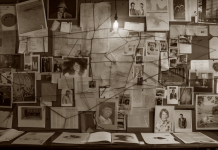
Looking back, it makes sense that Detroit-born Christopher Wilson would go on to help revolutionize the Smithsonian in Washington, D.C., by injecting its programming with theater and immersive experiences intended to engage modern audiences. After all, his mother, Joanne Wilson, did much the same in the late 1960s and early 1970s as host of an after-school Detroit Public Television show called Science Is Everywhere, in which she, too, labored to make some of the dry material taught in classrooms more interesting and accessible.
Wilson, 54, born on Detroit’s west side and a graduate of the University of Detroit Jesuit High School, the University of Michigan, and Wayne State University, is now both the director of experience design and the director of the African American History Program at the Smithsonian National Museum of American History. Before moving on to D.C., he spent almost two decades at The Henry Ford in Dearborn. Now sharing his life on the East Coast are his wife, Elizabeth, who is deputy director of fundraising at the Smithsonian’s National Air and Space Museum, and their two children.
Wilson chatted with şÚÁĎÍř Detroit about his illustrious career, the historic figures he’s come to know, and why it took him so long to see Hamilton.
şÚÁĎÍř Detroit: We’ll get to your career, but first, do you remember any particular episodes of your mom’s show, Science Is Everywhere, that you were on?
Christopher Wilson: Well, I was 4, so I couldn’t do much, but there was one episode about the moon and outer space, related to the NASA launches. They had me running around a construction zone they were pretending was a moonscape. So I picked up rocks and looked at them.Ěý
And what did your father do?
He was a supervisor at the Detroit Parks and Recreation Department. He actually gave Tommy Hearns his first job cleaning up around the gym where the boxers went. He became a family friend and would come by our house all the time. But before that, my dad was really trying to get hockey programs set up for inner city kids. He got an outdoor rink built at Northwestern Recreation Center with money appropriated from the Coleman Young administration. There was a big dedication ceremony where my granddad skated a lap and then I, as a 5-year-old, skated a lap.Ěý
You considered becoming a doctor. How did you end up a museum historian instead?
My freshman year at University of Michigan, I was on the track team and taking a lot of hard math and science classes, but it got to be too much for me. My second year, my counselor suggested I take something easier, so I took some art history classes, and I really enjoyed that. [Wilson eventually switched his majors to English and history.] And then, my father suggested I work a summer job at the Henry Ford Museum. He thought I’d enjoy working on the new historic working farm at Greenfield Village. He was right. First, I worked a sawmill there, then I started working at the Firestone Farm and loved it. I got to drive draft horses and shear sheep and plow the fields. It beat working at Bob Evans.
You stayed at The Henry Ford for 18 years. What changed in that period?
Well, it was during the mid- to late ’80s that a lot of museums began rethinking the extent to which they dealt in nostalgia for a version of America that never really existed and had little in common with actual academic history. Henry Ford had always been really experiential, but it became more interested in connecting those experiences to actual historical learning and imparting to visitors a more complex view of the past.
How did you get the job at the Smithsonian?
I held a number of jobs at The Henry Ford, working as a program leader for the agriculture as well as the Black history programs. I felt I had gotten as far as I could go, and I came across an opening for head of the African American culture program at the Smithsonian National Museum of American History. One thing that gave me a leg up was my background in experiential theater and other living-history programs at Greenfield Village and The Henry Ford. The director at the Smithsonian wanted to go in that direction. A lot of the experience of the museum was looking at objects behind glass and reading labels. They really wanted to change that, and I had the background to help do that.
Congress approved the creation of the National Museum of African American History and Culture at the Smithsonian around that time. Was there a tug-of-war over which Smithsonian artifacts would go where?
Well, it was 10 long years before the museum opened. There wasn’t a building at first, so we used some of the money allocated for the African American Museum to enact programming at the National Museum of American History. The [new museum’s] director, Lonnie Bunch, wanted people to know that the African American Museum existed, even though it didn’t have a building. The first program under the name of the new museum was called We Shall Overcome, which commemorated the 40th anniversary of the voting rights march from Selma to Montgomery. That was also my first big theatrical experience at the Smithsonian.
Theatrical experience?
Yes. With this one, I decided to do a performance that told the story. It was a living documentary that told the story of the march. We did it in an area we call Flag Hall. Everybody came in, we sang the songs, introduced some of the characters, and so forth. That was just very different from anything they’d ever really done at the Smithsonian.Ěý
You wrote, directed, and performed in that. Did you know you’d be good at it?
I thought I could do it. I took playwriting classes at Michigan. I was also a frustrated actor in high school. I would watch the plays at University of Detroit Jesuit. I could never be in them because I was an athlete and I was always at track practice. I would just daydream as I was running the stairs that I could be in a play, but I never was, so I decided to put myself in one at The Henry Ford. By the time I left there, we were doing major shows. We did one on the history of baseball called Play Ball that was a vaudeville-style show, and we had Ernie Harwell do the preshow recordings. At the Smithsonian, we started doing these shows, and a lot of times celebrities would come. We actually did a program with Lin-Manuel Miranda, but that’s a whole other story.
Tell it!
Well, it was right at the time that Hamilton was moving to Broadway, and I didn’t really know much about it. He offered me tickets, and I just said, “Hey, I gotta check my schedule,” and blew him off a little bit. And then, when I realized what Hamilton was becoming, I said, “Well, you know, I’ll be happy to take those tickets.” And he said, “Yeah, call me when I get back to New York.” I put him in his car — and he never answered the phone again. He got back to New York, the show blew up, and he forgot I existed. I resisted seeing the show for two years because I should have, could have, seen the original cast. I was salty about the whole thing for a while. That was because I was stupid.
When does a news event become historic enough to be of interest to the Smithsonian?
I’m not a curator and don’t have much involvement in collecting physical artifacts, but we are always collecting. A colleague of mine went to the National Mall on Jan. 6 to go through the garbage and collect signs and weapons and other things left from the attack on the Capitol. Thankfully, that’s not the kind of thing I have to deal with very much.Ěý
Do you go into storage to see things that aren’t on display for fun?
Sure! That is one of the great things about being at two of the world’s biggest history museums with world-class collections. At The Henry Ford, until Ford’s contract with the government went to GM, we used to get all the presidential limousines. The Kennedy cars are there, and I remember the day that the car that Reagan took shelter in while Hinckley was shooting at him came in. We got to touch it and go all through it. And even more so at the Smithsonian. We have George Washington’s christening blanket. Some of my favorite objects are the pumps that Juanita Williams, the wife of one of the Selma march organizers, wore while marching 40 miles to Montgomery. They were new when she started, and they’re all ground down.Ěý
Any other good celebrity stories?
That’s one of the cool things about being at the Smithsonian — you never know who’s going to be there. President Obama’s daughters came to one performance and liked it, and the next thing you know, I get a letter from Michelle Obama asking if we would come perform it at the White House! That doesn’t happen in Detroit.Ěý
Did you perform for the president?
No, we just did that program for visitors to the White House. We didn’t do it in the West Wing. I was hoping and waiting for that.
In your Twitter feed, you drop phrases like “the Rosa Parks I knew.” Is it wild to you that you know some of these people?
Oh, it’s huge. I got to meet Rosa Parks when I gave her a tour at Greenfield Village in 1992. One of the first programs I did at the Smithsonian in 2004 was a discussion on a PBS film called February One about the 1960 Woolworth’s lunch-counter sit-in in Greensboro, North Carolina. Through that, I got to meet Joe McNeil and Frank McCain — two of the four who started the sit-ins. Frank has passed away, but Joe still lives in New York, and I call him often. I think about knowing people like that. I couldn’t be happier about it.
There’s a debate right now over “critical race theory” — the notion that modern race relations were shaped by historical racism — and conservative efforts to prevent its teaching in public schools. Has this controversy infiltrated museums?
So far, not really. But there have always been controversies over the ways history is defined and presented. I’ll give an example. The Civil War Remembrance program at The Henry Ford evolved from an older program, which I remember going to as a kid, called the Muzzle Loaders Festival. It was a day where the museum was taken over by Civil War reenactors, and it was really about the guns and the accoutrements from the Civil War and the Revolutionary War. Well, The Henry Ford announced it wouldn’t be putting on that program this year, and if you look on Facebook, a lot of the audience is saying, “Oh, they’re just going to cancel history now,” and such. And I’m thinking, “They’re not canceling history. They’re just not doing history by having people dress up and play-act the Civil War.” But a lot of times, the public wants its museums to teach about the past in a way that allows them to feel comfortable.
This story is from the April 2022 issue of şÚÁĎÍř Detroit. Read more inĚýour digital edition.
|
| Ěý |
|








